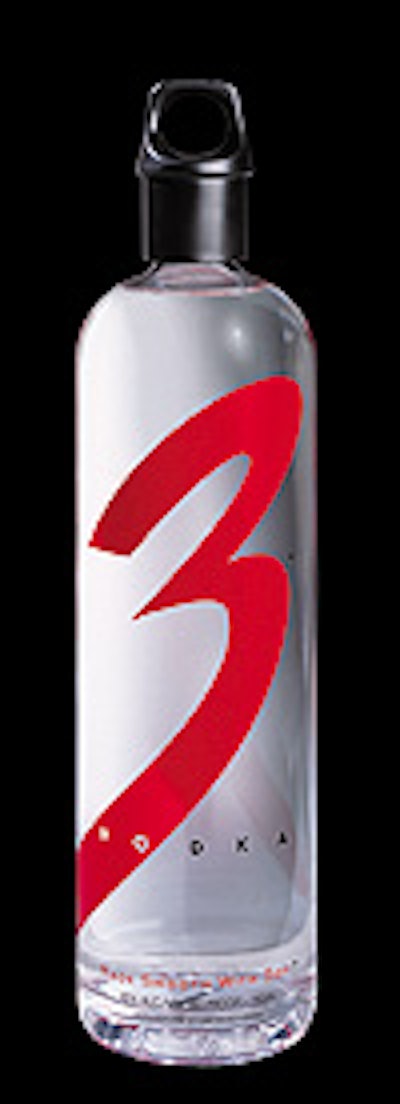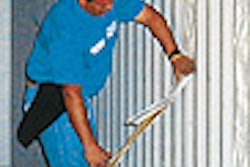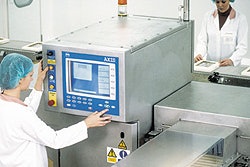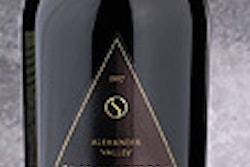Convinced that its unique new vodka required equally impressive packaging, 3 Vodka Distilling Co. developed a 750-mL glass bottle emblazoned with a bright red 3 that is something of a departure in decorating technology. According to Brian Berish, managing partner of the Chicago-based firm, the only way to achieve a red in this precise hue is to screen-print with organic inks that are subsequently cured in a lehr. Closely resembling applied ceramic labeling, this technique has been used for other products, notably cosmetics. But this is believed to be the first application in the wine and spirits sector.
Further touches of innovation include unconventional embossing in the bottle’s punt (base area), a patent-applied-for closure, and litho-laminated corrugated shippers with high-impact graphics and die-cuts that mimic the bottle’s unusual cap. Working with 3 Vodka on package design was Wencel/Hess Design (Chicago, IL).
As for the vodka itself, its taste is enhanced by soy isolates. According to Brian Berish, this marks the first time that soy has been distilled. Combined with select grains through a painstaking distillation process, the soy isolates give the vodka a smoothness and taste unrivaled in the category, claims Brian Berish. That’s why no ordinary packaging could possibly do.
“The premium vodka category, though crowded, is doing well,” says Brian Berish. “But from a packaging standpoint, it seems like everyone in the category is in a race to see who can develop an even taller and frostier bottle than the tall, frosty bottle introduced last month. There are too many me-too approaches.”
Through packaging distributor Saxco (Horsham, PA), Brian Berish and his fellow managing partners, brothers Barry and Brett, found a glass bottle that could cut through the clutter. Custom made in Italy by Vetri Speciali, the bottle is, as Brett Berish puts it, “not short, not tall, not fat, not thin. And it has a clarity that is unmatched. We knew what we wanted and Saxco helped us find it.”
Embossed 3s
Further distinguishing the flint bottle are two embossed 3s, one on the back just below the threads and the other on the punt.
“The glass company initially said the embossing on the punt couldn’t be done because the punt typically isn’t so horizontally oriented,” says Brian Berish. “But we really wanted that embossed 3 on the bottom of the bottle. To make that happen, we pressed for a punt that was primarily flat rather than concave like a wine bottle.”
At the same time the glass bottle was being developed, decoration was explored, too. The popular no-label look, achieved with a clear-film pressure-sensitive label, was briefly considered. “But we didn’t want the feel of a label that can be pulled off,” says Brett Berish. “We wanted something more tactile and permanent.”
Applied ceramic labeling became a strong contender. “But we couldn’t find the lustrous, bold red we wanted,” says Brett Berish. That led to some research into ink suppliers, and eventually a supplier of organic inks surfaced. While choosing not to identify who the ink vendor is, Brett Berish claims that the decorating company, Chattanooga Labeling Systems (Chattanooga, TN), is one of only a few that works with such inks. “A lot of trial and error was involved,” he adds.
Chattanooga Label uses three colors, including red for the 3 and black for the copy on the back of the bottle, while white provides the background for a bar code, also on the back.
Decorating about 30 3 Vodka bottles/min, Chattanooga uses the same screen-printing equipment and the same lehr that it uses when applying ceramic inks to glass bottles in ACL applications. But when fusing ceramic inks to a glass surface, lehr temperatures are in the range of 1150°F. Organic inks, on the other hand, are fired at about 350°F. As a result, the organic inks are neither fused to nor inseparable from the glass surface the way they are in ACL. But under ordinary distribution and use, the big bold 3 has all the permanence of ACL decoration, says Brett Berish.
‘Something memorable’
Even a cursory glance at 3 Vodka’s patent-applied-for closure reveals how unconventional it is. “We wanted something sleek and contoured and memorable,” says Brian Berish. They got it, too, in an injection-molded plastic threaded closure that weighs 33 g. Made in China and sourced through Saxco, it’s functional, as well: two capfuls equal a traditional shot.
So pleased were they with the way the closure turned out, the Berishes decided to echo it in the structure and design of their corrugated cases. In the bottle likenesses that appear on both the 3- and 12-count shippers, each cap image has a die-cut hole in the same place that the actual cap does.
Pride Container (Chicago, IL) makes the 200#-test, B-flute corrugated shippers, both the 12-bottle version that goes to the retail trade and a smaller three-bottle version for foodservice distribution. Pride makes single-faced sheets on its corrugator and then takes the sheets to a laminator. Here, the top liner, a 10-pt paperboard printed offset in four colors and overlaminated with a ½-mil low-density polyethylene film, is laminated to the single-faced corrugated. Next, a die cutter cuts out individual blanks, including 10 cap holes in the 12-count shipper and five in the three-count, before the sheets go to a gluer to be joined.
“Knowing the shippers were destined for retail display, we thought it critical to provide something that looked so great it enhanced the appearance of the store aisle,” says Brett Berish. Since the first run, however, one lesson learned is that the high-gloss film surface was so slick it wouldn’t accept ink-jet coding of lot and date code. So that information had to be printed on a paper label and applied separately. Cases made by Pride Container in the future will substitute a UV-cured coating in place of the film lamination. “It looks just as good but it eliminates that need to apply a separate label,” says Brett Berish.
The three-count shipper allows a bar or restaurant to order less than a full 12-bottle case without having to pay the typical distributor “breakage fee.” According to Brett Berish, retailers will also be able to sell the three-count cases as a gift pack during the holiday season. A plastic handle in the top flap adds to this gift-pack quality.
Filled semi-automatically by an unnamed contract packager, 3 Vodka is capped by hand. Thread starts in the closure match those in the bottle’s neck finish so that when the closure is torqued down tight, the distinctive hole in the closure is properly aligned with the front of the bottle.
Introduced first in Florida and Illinois, 3 Vodka will be rolled out nationwide, says Brian Berish. It retails for $24.99 per bottle.
























